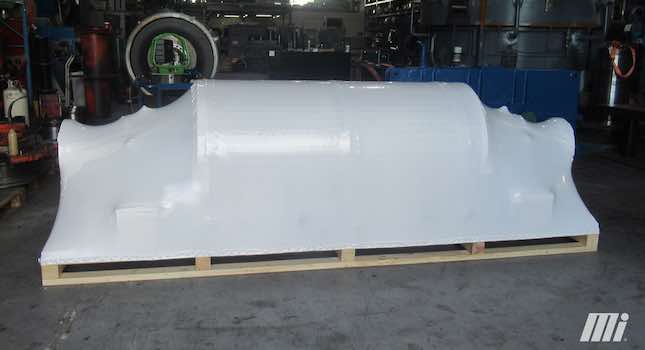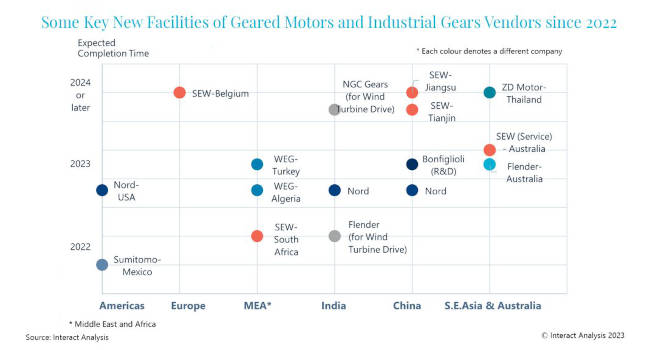Environmental concerns and the awareness of limited resources accompanied the shift away from reciprocating air compressors, which required enormous amounts of lubricant, and discharged it into the air and the environment. The shift to rotary and centrifugal compressors addressed these issues and resulted in greatly reduced consumption of lubricants.
Key Concepts
Synthetic lubricants were developed to eliminate varnish buildup in compressors.
Synthetic lubricants last up to 12 times longer than hydrocarbon lubricants.
Synthetic lubricants reduce component wear.
Sections: Inside compressors Improved cost/performance Keys to performance Compressor types Reciprocating compressor lubrication Rotary screw compressor lubrication Centrifugal compressor lubrication When not to use a synthetic Analyzing compressor fluids Fluid change interval
Sidebars: Recycling compressor lubricants Typical synthetic benefits
Environmental concerns and the awareness of limited resources accompanied the shift away from reciprocating air compressors, which required enormous amounts of lubricant, and discharged it into the air and the environment.
The shift to rotary and centrifugal compressors addressed these issues and resulted in greatly reduced consumption of lubricants, did a better job of keeping fluid in the compressor, but also increased demands on the fluid.
Hydrocarbon lubricants in rotary air compressors were frequently changed to avoid varnish problems in the compressor. Synthetics were developed to resolve those problems. Many synthetics are now biodegradable and even have limited solubility in water. This usually means the small amount of lubricant that leaves with the compressor condensate causes no problem for wastewater treatment plants.
Another trend is the reduction of labor for maintenance. Longer-life fluids and compressors requiring less maintenance have accompanied this trend. The megatrend toward energy conservation was met with a new generation of rotary compressors, incorporating two stages, capacity controls, variable speed drives, and varnish-free synthetic lubricants that prevent the loss of energy efficiency.
Because of the combination of heat and concentrated oxygen inherent to air compressors, this application pushes the limits of what lubricants can withstand.
The service life of synthetic lubricants could reach 12,000 hr, lasting about 18 months in 24/7 operation. Actual life will vary, depending on the conditions of the specific application. Under these severe conditions conventional mineral oils typically last only 1000_2000 hr. By comparison, lubricants made from synthetic base stocks extend the drain interval.
Inside compressors
In a compressor, the fluid is recirculated in a closed system. It flows from the compressor to the receiver tank, which contains the oil separator. From there it flows through a particulate filter, an oil cooler, and back to the compressor. Varnish formation in the lubricant can plug coolers or oil separators, or block oil flow to bearings, causing catastrophic failure of the compressor.
Many fluids have difficulty surviving the combined attack of air and elevated temperatures, typically up to 210 F. Oxidation occurs rapidly because of reactions between impurities in the lubricant, especially in mineral oil, and the oxygen in the compressed air. Oxidation is accelerated by heat, causing an increase in viscosity and lubricant failure.
Improved cost/performance
Lubricating air compressors with synthetic compressor oils is a cost-effective way to extend maintenance intervals and optimize compressor performance. Savings are possible because synthetic oils greatly extend changeout intervals and eliminate varnish buildup inside compressors.
For example, a rotary screw compressor system requiring 30 gal of lubricant typically needs only one fill of synthetic compressor oil, compared with five fills of conventional mineral oil in the same time period. This represents a saving in oil cost of about 13%. Add to this the savings in labor, fluid disposal, and less frequent filter changes and the total annual cost saving is 40%.
Keys to performance
Above the operating temperature of 180 F, the lifetime of a mineral-based lubricant is cut in half by every 20°F increase in temperature. As a mineral oil degrades, byproducts of its breakdown may cause a buildup of a hard, sticky varnish on internal metal surfaces. This buildup adversely affects compressor performance.
Synthetic lubricants have greater resistance to oxidation at rated operating temperatures and reduce heat-generating friction. They achieve full lubrication at startup and reduce component wear. The synthetic’s resistance to oxidation and other properties leads to longer service life, efficient lubrication, and less formation of undesirable byproducts in the lubricant.
The molecular structure of the advanced synthetic fluids effectively withstands short-term temperature spikes as high as 250 F without damaging the fluid. The result is improved lubricity and virtual elimination of varnish formation.
Compressor types
There are currently three main types of compressors used for industrial air compression: reciprocating, rotary screw, and centrifugal. The lubrication needs and types of lubricants commonly used in these machines, and the factors that should be considered in evaluating them are different for each application.
Reciprocating compressor lubrication
Reciprocating compressors can be viewed as two distinct groups: single-acting and double-acting machines.
Smaller, single-acting units are typically splash lubricated (Fig. 1). Temperatures of 400 F in the compression cylinder can be expected. There is typically no filtration and the same lubricant functions throughout the unit.
The lubricant in these units sees relatively severe thermal stress. Due to small sump sizes, high temperatures, moisture accumulation, and lack of filtration, fluids with good antiwear properties are normally employed.
Most large, reciprocating compressors are of the double-acting type. A crosshead isolates the cylinder, where compression occurs, from the sump, allowing the utilization of two different lubricants to meet the specific needs of each location. The sump of the double-acting machine is a mild environment and hydrocarbon oils are typically used there.
Temperatures are typically in the 160_200-F range, with little aeration, resulting in a very mild oxidizing environment. In this application, a lubricant may thrive for several years before analysis indicates a need for service.
Rotary screw compressor lubrication
Rotary compressors are compact and efficient (Fig. 2). Small sump sizes mean a small fluid capacity and increased demands on the fluid. Fluid replenishment rate is a key factor in the fluid life in these units. There is also a trend to higher pressures and higher discharge temperatures.
Rotary compressor fluids need to meet several other unique requirements and critical functions that are different from other types of compressors. Volatility, or vapor pressure of the fluid should be low, to reduce the carryover rate of fluid downstream with the air. Corrosion protection is also critical in an environment where the lubricant is in constant contact with large volumes of atmospheric air laden with moisture and other contaminants.
Varnish formation must be avoided. Varnish in the orifices and passages leading to air-end bearings starve the bearings of lubrication, resulting in catastrophic failure. Varnish on rotors or stators restricts clearances, resulting in increased frictional losses, energy consumption, and operating temperature. A varnish coating on the separator shortens separator life, and increases differential pressure, further eroding energy efficiency.
Centrifugal compressor lubrication
Centrifugal compressors differ from rotary and reciprocating compressors because the lubricant is not in contact with the air that is being compressed (Fig. 3). The fluid serves only as a bearing and gear lubricant. A centrifugal compressor fluid has less severe oxidative stability requirements.
It is critical that the lubricants in these units do not form deposits or varnish on bearing surfaces. Bearing clearances typically may run as little as 0.001 in., and any significant reduction in clearances can result in overheating and damage to bearings.
The fluid condition of synthetics in centrifugal compressors is easily monitored. Proper viscosity, viscosity increase, and particulate levels are a critical concern in these units, as bearing designs and rotor stability are dependent on proper fluid viscosity.
When not to use a synthetic
Nearly all compressor manufacturers now use and recommend long-life synthetic fluids. Exceptions to those recommendations are generally made after the fact, when an application is found to have excessive levels of acid gases and other air contaminants that cause early fluid failure, or accumulate in the fluid to cause corrosion in the compressor. In those cases, hydrocarbon fluids are generally recommended because of low cost, and the fluid is changed on a 1000-hr or more frequent schedule.
Analyzing compressor fluids
What are the goals of an oil analysis program? The most basic goal is to establish a fluid change interval, and to ensure the fluid in use is still suitable. Second, and unique to rotary compressors, analysis serves to identify problems and contamination in the inlet air, which is manifested as chemical and particulate contaminants in the fluid. Finally, various tools for particulate measurement are useful in tracking and alerting to wear conditions.
Fluid change interval
The change interval for rotary compressors is typically dictated by contamination or the oxidation state of the lubricant as measured by several metrics. The typical change interval for synthetic rotary compressor fluids suggested by manufacturers is 8000 hr. This number is usually conservative, as many users do not perform any analysis at all, using only the change interval recommendations.
Under good conditions with no contamination, the actual life of synthetic fluids, as measured by analysis, can reach 12,000 hr. A conservative change interval may still be wise to avoid contaminating the new oil, due to the difficulty of getting all the old oil out of the compressor.
For centrifugal compressors, actual fluid life with polyglycol and other advanced synthetics may exceed 50,000 hr under normal conditions, due to the extremely mild nature of the oxidative environment, and limited opportunity for contamination. Typical recommendations, in the absence of analysis to verify fluid condition, range from 8000 to 16,000 hr. The lower the operating temperature, the longer the synthetic fluid will last.
PLANT ENGINEERING extends its appreciation to the Dow Chemical Co. for its assistance in the preparation of this article.
Recycling compressor lubricants
For the name of a waste lubricant recycler in your area, contact the National Oil Recyclers Association (216-791-7316.) or visit their website at
What do they do, what does it cost?
Most recyclers collect the fluid, charging a nominal flat fee for pickup plus about $25 per drum. Some have minimum amounts. Typically, these companies then filter the fluid, dehydrate it, and sell it as bunker fuel for utility companies, asphalt plants, cement kilns, or industrial boilers. This practice reduces the use of new fuel oil while eliminating a waste product.
What types of fluid will they take?
Typically, oil companies do not care whether the fluid is petroleum oil or synthetic, just so certain items are not mixed with it. They do not want the oil to be mixed with antifreeze, transformer oil (PCB’s), solvents, or excessive water. But it usually does not matter if petroleum oil is mixed with the synthetic, since it will be used as fuel. The recycler may want to know what the fuel value (Btu/lb) is.
Drum Disposal
Drum recycling companies are located in most major cities. The recyclers require that the drums, which have contained products such as lubricants, be as empty as possible by simply tipping them. Drums, which have contained hazardous materials, must be triple rinsed. Note: The rinse solvent from hazardous materials is also considered to be hazardous. Most common types of synthetic lubricants are not considered hazardous material for purposes of drum disposal.
Qualification
Caution: Before using any oil or drum recycling company, it is highly recommended that you confirm that they are properly disposing of the product. For example, do they have a state or EPA permit number? The generator of the waste (user of the product) is responsible for its proper disposal, even though an oil hauler may have carried it away.
Typical synthetic benefits
Fewer oil changes
Fewer filters
Fewer replacement parts
Fewer maintenance interruptions
Lower waste lube disposal costs
Lower labor costs
Power and energy savings
Extended equipment life



